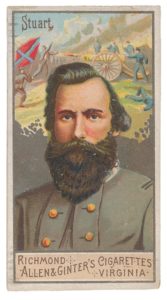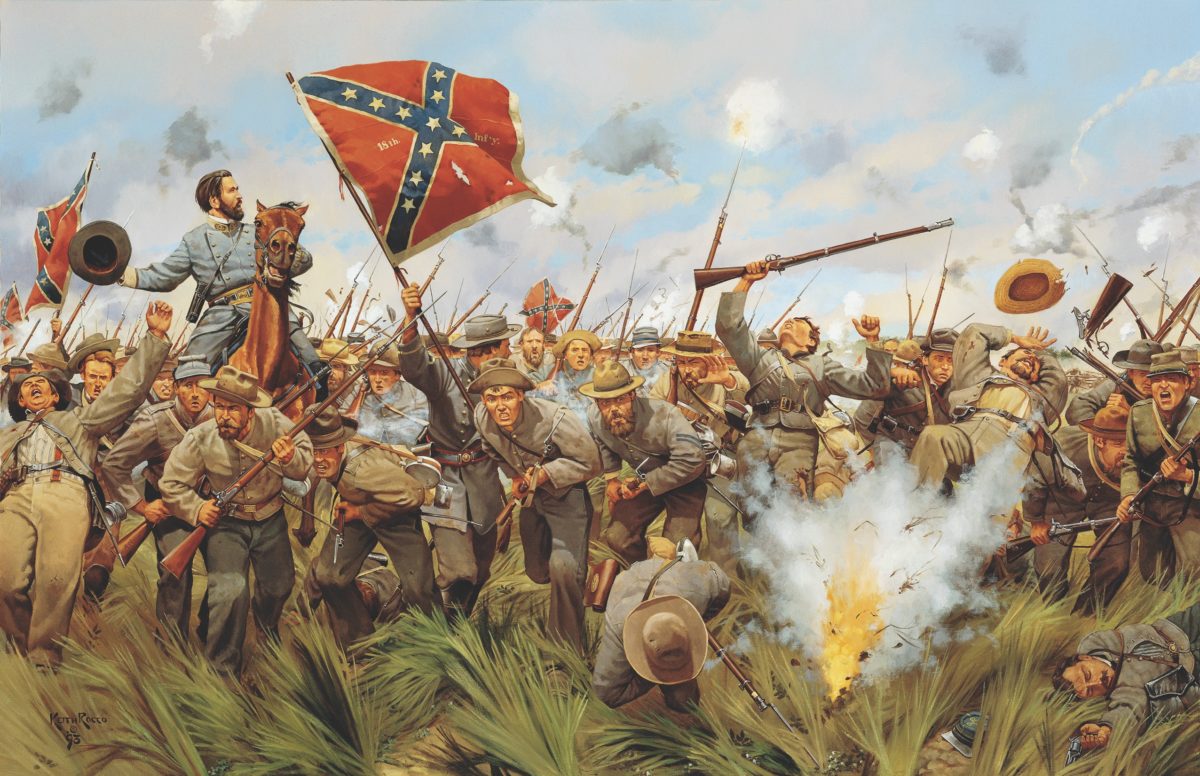All Civil War battles have their share of myths, but Gettysburg seems to be in a league of its own. One of the more enduring ones—one I heard frequently when I worked at Gettysburg National Military Park—was that during Pickett’s Charge on July 3, J.E.B. Stuart’s cavalry was supposed to charge in and strike from the rear at the same time George Pickett and his fellow generals broke the Union center along Cemetery Ridge.
As with many myths, there is a granule of truth here. But tracing the origin of these myths is difficult because they often result not from a single source but from an accumulation of accounts that morph over time into a single narrative, one repeated so often the myth that evolves generally becomes accepted as fact.
How the Myth Started
Stuart’s attack upon the Union rear on the battle’s third day is a prime example. This narrative appears to have evolved from a Union account of 1878: William Brooke-Rawle’s The Right Flank at Gettysburg, a pamphlet covering the July 3 Union cavalry operations beyond the Army of the Potomac’s right flank and the engagement with Stuart’s cavalry on what is known today as East Cavalry Battlefield. Brooke-Rawle, a 3rd Pennsylvania Cavalry lieutenant who fought there, maintained that had Brig. Gen. David McM. Gregg’s cavalry not checked Stuart, July 3 “would have resulted differently, and instead of a glorious victory, the name of ‘Gettysburg’ would suggest a state of affairs which it is not agreeable to contemplate.” In other words, the Army of the Potomac would have lost the battle if Stuart had been allowed to run amok in the Union rear.

In 1956, Edward Stackpole published the widely read They Met at Gettysburg and picked up Brooke-Rawle’s theme that the cavalry battle had been “neglected by historians,” and its importance not appreciated. Stuart’s role in Lee’s July 3 battle plan, Stackpole would write, was to exploit the anticipated breakthrough of Pickett’s Charge by circling the Confederate left and coming in on Maj. Gen. George Meade’s rear “at the psychological moment and giving the Army of the Potomac the coup de grace.” In describing Lee’s intentions in High Tide at Gettysburg, published two years later, Glenn Tucker at first accurately summarized Stuart’s role by writing, “Stuart would be sent to Meade’s rear to aggravate and pursue the Federals in case Pickett and Pettigrew achieved a break-through,” but then later tied Stuart’s operations directly to Pickett’s Charge in declaring that Stuart’s “part in the effort to break the Federal center on July 3 was entirely negative.”
The myth received a fresh infusion in 2005 when Tom Carhart argued in Lost Triumph: Lee’s Real Plan at Gettysburg and Why It Failed that if Lee’s plan worked as intended, then “Stuart’s troops would meet Pickett’s men at or near the Clump of Trees.”
Adding even more weight was the viewpoint of the millions who saw the old Gettysburg NMP Visitor Center’s Electric Map program (now reconfigured and in a new home in nearby Hanover, Pa.). It graphically illustrated with electric lights how Stuart was to swoop in from the rear while Pickett assailed the Union center. With such an onslaught of books, pamphlets, articles, and orientation programs all repeating the same general theme, it is no wonder the myth of Stuart’s attack on the Union rear became firmly entrenched in the popular memory of the battle.
J.E.B. stuart’s real Role
If the idea that Stuart was to smash into the Union rear is myth, then what exactly was his role? Lee’s and Stuart’s after-action reports are illuminating in different ways. When Lee described his plan for July 3, he didn’t even mention Stuart’s role—not because he wished to keep it secret or shield Stuart from embarrassment, but because Stuart’s role on July 3 was intended to be only secondary to the infantry operations. Lee would provide a detailed account of the campaign’s cavalry’s operations in his report, but of July 3 he merely wrote that Stuart’s troopers “engaged the enemy’s cavalry with unabated spirit, and effectually protected our left.”
Stuart, however, wrote: “I had such a position as not only to render [Maj. Gen. Richard] Ewell’s left entirely secure, where the firing of my command, mistaken for that of the enemy, caused some apprehension, but commanded a view of the routes leading to the enemy’s rear.” If the enemy’s main position had been dislodged, “as was confidently hoped and expected,” Stuart believed he was “in precisely the right position to discover it and improve the opportunity.”
GET HISTORY’S GREATEST TALES—RIGHT IN YOUR INBOX
Subscribe to our HistoryNet Now! newsletter for the best of the past, delivered every Monday and Thursday.
What is quite clear here is that Stuart’s primary mission was not to go thundering into the Yankees’ rear but to protect the left flank and rear of the army from a possible thrust by Union cavalry. Rather, he was to threaten the enemy rear and communications—to discover and “improve the opportunity” should the main offensive dislodge Meade’s army and force a retreat. In other words, there was no plan for Stuart to assault the Union center when he began his movements. Lee’s original plan called for simultaneous attacks by Longstreet’s and Ewell’s corps on both flanks. When Lee was forced to modify his plan—what resulted in Pickett’s Charge—he may well have communicated the change to Stuart. Stuart, however, makes no mention of it, probably because it was immaterial to the role his cavalry would play.
not napoleon
Primary evidence refutes the prospect Stuart was to attack the Union rear while Pickett et al. assailed the front, and it is also inconceivable that Lee would even have risked his valuable cavalry with such a shock assault. The Civil War was not another Napoleonic War; it was its own conflict with elements of the Napoleonic War. Close-order infantry tactics, in particular, were still in use because of weapons and communications, but cavalry tactics were one area that had changed considerably. Rifled weapons had made using cavalry as shock troops—a common feature of Napoleonic battles—rare and exceptionally dangerous for the troopers themselves.
Stuart’s mission on July 3, as he described it in his report, is entirely consistent with the effective use of cavalry during the war—to screen an army’s flank, threaten enemy communications, and be in position to act as a pursuit force in the event of an enemy retreat. This is the granule of truth contained in the myth: Stuart would strike into the enemy rear if the opportunity presented itself and he could get by the Union cavalry.
No doubt the myth of Stuart meeting up with Pickett at the Copse of Trees will endure and my feeble effort at relegating it to history’s dustbin will fail. Some myths are uncommonly stubborn things to dislodge.
Scott Hartwig writes from the crossroads of Gettysburg.
historynet magazines
Our 9 best-selling history titles feature in-depth storytelling and iconic imagery to engage and inform on the people, the wars, and the events that shaped America and the world.






